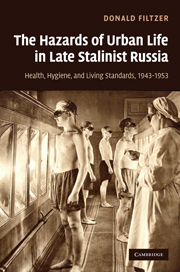Book contents
- Frontmatter
- Contents
- List of figures
- List of maps
- List of tables
- Preface and acknowledgements
- List of terms and abbreviations
- 1 Map of the regions covered in the book, from Moscow in the west to Kemerovo oblast' in Western Siberia
- 2 The Volga and Kama River networks
- 3 Moscow and Moscow oblast'
- 4 The Urals and its major rivers
- The Kuzbass and the River Tom'
- Introduction
- 1 The impossible task: keeping cities clean
- 2 Water
- 3 Personal hygiene and epidemic control
- 4 Diet and nutrition: the 1947 food crisis and its aftermath
- 5 Infant mortality
- Conclusion
- Bibliography
- Index
1 - The impossible task: keeping cities clean
Published online by Cambridge University Press: 06 July 2010
- Frontmatter
- Contents
- List of figures
- List of maps
- List of tables
- Preface and acknowledgements
- List of terms and abbreviations
- 1 Map of the regions covered in the book, from Moscow in the west to Kemerovo oblast' in Western Siberia
- 2 The Volga and Kama River networks
- 3 Moscow and Moscow oblast'
- 4 The Urals and its major rivers
- The Kuzbass and the River Tom'
- Introduction
- 1 The impossible task: keeping cities clean
- 2 Water
- 3 Personal hygiene and epidemic control
- 4 Diet and nutrition: the 1947 food crisis and its aftermath
- 5 Infant mortality
- Conclusion
- Bibliography
- Index
Summary
Sanitation in European cities in the nineteenth and early twentieth centuries
Soviet cities after the war were filthy places, covered for most of the year in piles of garbage, mounds of human excrement, and torrents of raw sewage flowing through open gutters or simply spilling out onto streets and sidewalks. There was nothing novel about this, nor historically unique. If today those who live in the industrialized world take flush toilets and closed sewerage systems for granted, it is a staggering fact that nearly half the world's population, some 2.6 billion people according to the United Nations, still live without adequate sewerage, and 1.8 million children die every year from diarrhea and other sanitation-related diseases – and this at the end of the first decade of the twenty-first century. It is equally easy to forget that clean water and modern drainage are relatively recent innovations, even in the “West.” The great waves of sanitary reform in the cities of Britain, Germany, and France began in the middle of the nineteenth century, but neared completion only during the first decades of the twentieth. Europe's rapid industrialization during the nineteenth century caused an equally rapid surge in urban populations, more specifically, in the urban working class, who crowded into towns and cities and lived in cramped, ill-lit, poorly ventilated, and inadequately heated homes with few if any sanitary facilities. With the people and the slums came problems of how to collect and remove their waste.
- Type
- Chapter
- Information
- The Hazards of Urban Life in Late Stalinist RussiaHealth, Hygiene, and Living Standards, 1943–1953, pp. 22 - 65Publisher: Cambridge University PressPrint publication year: 2010



